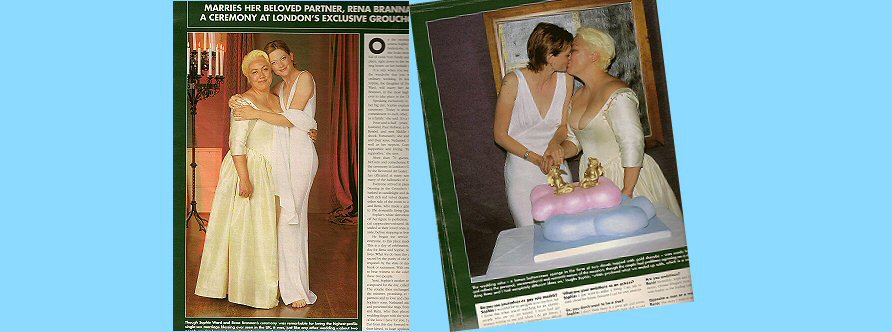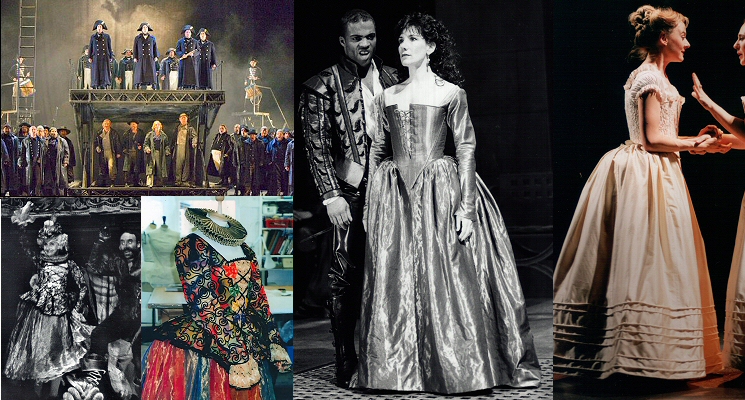| After finishing school, A' levels, and Foundation level Art and Design, I was fortunate to gain a place on the extremely popular “Theatre Wardrobe” course at Wimbledon School of Art in 1986. (This is now re-titled “Costume Design Interpretation” and while still at Wimbledon, comes under the umbrella of University of the Arts, London). At the time it had a reputation for a one hundred percent success rate placing it’s graduates in employment - mainly with the major ballet, opera and theatre companies, with the BBC and in costume departments supplying film companies. To me, besides period costume, it was the only place to learn ballet tutu construction. I had determined from an early age that if I couldn’t be on the stage (too short!) then I would be behind it and my work would perform! (My portfolio at the time was full of sketches of period costume from museums, prototype tutus and wedding dresses).
Long before graduation we were given small jobs “in the business“, working as assistants to our tutors, the majority of whom were established freelance costumiers. My very first job, still in my first year, was “knotting” an extremely long blonde wig for a performance of “Sleeping Beauty”. We made tutus for Rambert students, 'remake' costumes for “Les Misérables”, learned the basics of hat-making, stage make-up, dyeing, headdress and jewellery construction suitable for stage and screen. At the same time we attended lectures, wrote lengthy essays, dissertations and sat exams on the History of Art, Fashion and Architecture and Theatre history.
Pattern-cutting skills - both on the stand and flat were of great importance at Wimbledon. We worked gradually through the centuries in men’s and women’s dress to the modern day. Always we had to strive for the highest quality of finish - from pattern-drafting, via fitting to finishing and trims. We were taught how to cut, fit and construct period corsets and frames to give a gown the perfect silhouette for the period.
It might surprise the man-on-the-street to know that companies such as the Royal Ballet, Royal Opera, Glyndebourne and the Royal Shakespeare company are sources of the highest couture standards - on a par with the top fashion and bridal houses. There is a misconception sometimes, by those who do not know, that "finish" is the difference between fashion and costume trained designers. The cliché about glamerous sparkle on the outside, yet rough on the inside is simply wrong for the part of the theatre world I work in. With professional theatre costume, the only difference between "costume" and bridal dresses is that costumes do not have an additional lining directly next to the skin. However, they will still be formed of a combination of top fabrics and interlinings which might add up to five or six layers. The "inner workings" are more on display with a costume and have to have a perfect finish - all seams edged, bones fully encased and safe for the artist to wear. No raw edges or wrinkles here! With my wedding gowns, there is an additional fabric lining next to the body with seams on the inside. A theatre costume might be made-to-measure for one particular performer, but they can be injured at short notice. Seams have to be easily attainable with theatre costumes - you never know when a dancer might strain a tendon in the twenty minutes prior to performing. Suddenly an alternative cast is dancing and the costume needs to be taken-in in the course of the Prologue! Understudies are not an issue for wedding gowns(!), so dresses are fully lined.
On the high street, with costume, as with wedding dresses, there is a variety of qualities and standards of construction and finish available. The local fancy dress hire shop is probably at the bottom of the scale, but is, unfortunately most people's idea of "Costume". At the other extreme, there are some stunning period and fantasy costumes in films such as "Orlando", "Dangerous Liaisons", "Elizabeth" and "Shakespeare in Love" - or visit the Royal Opera House - this is the quality of work I strive to provide.
A trained and experienced cutter knows where to place seams, boning and which combination of interlinings to use to achieve bodices, sleeves and skirts which fit like a second skin without a wrinkle in sight. With the top theatre and film companies these costumes can be made from the most sumptuous fabrics, imported from all parts of the world. Consider the quality of workmanship needed to be displayed in detail across a cinema screen. Some might argue that the design budgets for performances of this quality are needlessly large, but these costumes are usually destined to last for decades and to enhance the performances of our most elite dancers, singers and actors. Performers are quick to comment if a costume is likely to affect or inhibit their performance! I learned more couture techniques at the RSC (thank you Norma!) than while working for any bridalwear designer.
On graduation, I worked freelance, assisting on many ballet jobs for various companies. (I did not realise that I had worked on one of - then unknown - Darcey Bussell’s costumes: “Winter” in “Cinderella” until I read her autobiography!) My days were spent beading and applying appliqué to costumes or wiring and decorating headdresses for countless court ladies fairies and swans. Looking back, I am glad I did not attempt to run my own business at this stage. I am extremely appreciative of the many generous souls I have worked for and with: designers, costume-makers, couturiers and craftspeople. They have passed on their own skills - secrets of cut and fit which are not found in text-books on fashion or period costume.
When the opportunity arose, it was not a great jump to transfer the above skills to working for a Bridal House, who were looking for a cutter/maker with a “theatrical background”. These few years working for Ritva Zestenius (who these days produces far more clean-cut glamorous gowns, very different to the style of the late 1980’s) honed my couture skills and gave me confidence in applying the cutting shears to fabrics costing three-figure sums per metre!
I was also lucky to be Ritva's appointed sample maker at the time, cutting and constructing new designs - this meant I frequently had photos of my work in bridal and celebrity magazines. Commissioning clients for this bridalwear house ranged from Nigel ("Young Ones") Planer's and Nick ("Pink Floyd") Mason's fiancées, to making the wedding gown for Breakfast Televisions's "Bride of the Year" for 1989.


There followed a period of mixed employment and freelance work - working for various couture bridal houses - in particular designing for “Cocoa” of Cheltenham who specialised in beaded twenties flapper dresses at the time. This was interspersed with headdress and jewellery making for ballets - including English National Ballet’s “Alice in Wonderland”. A sample "Cocoa" gown I designed was used in 2000 by the actress Sophie Ward's Bride, Renna, in what was described at the time as "one of the most high-profile lesbian weddings ever to take place in the UK."


The Royal Shakespeare company was a happy return to period costume - specialising in ladies. I made costumes for some wonderful actresses including Diana Quick, Jane Lapotaire, Donna Croll and Jane Gurnett. It was at the RSC that I very clearly saw the difference between those members of staff with a theatre training and those with a fashion background - I realised I am so lucky to have such a mixed background of all types: couture, theatre and fashion. A theatre training makes you think much more laterally about how to use fabric to achieve a desired effect. You don't just take fabrics at face value, but manipulate, layer, cut into, bead into, layer some more: all to achieve the desired effect. I have heard unitiated bridal designers talking in very derogatory terms about designers from my kind of background - unfortunately it is a measure of their ignorance of this kind of training: it is easy to knock what you do not know or understand. They seem to think a grounding in Theatre Wardrobe/ Costume Interpretation means you can only produce garish wedding gowns with raw edges! Yes, I do understand how to make stunning, sparkling costumes which read well from the back row of the stalls. I know how to make a paste jewel glitter like the crown jewels to the audience in the upper slips! I also understand how to work with the most subtle of fabrics - an Ophelia of the finest french silk tulle with chiffon flowers.... and this has influenced my wedding gowns. My most popular styles have an element of romanticism with a theatrical twist: it is wonderful to feel everything coming together! There was a wonderful atmosphere at Stratford at the time - you were quite likely to find yourself queuing with a famous face from stage or film in the local Marks and Spencer, then later the same day be pinning them into costume in the fitting room. We were able to watch dress-rehearsals on a regular basis in the Swan Theatre or Royal Shakespeare Theatre and wander beside the Avon during lunch breaks: quite idyllic!

I was always a little sentimental(!) about spending hours at the Royal Shakespeare Company in the workroom depicted in the famous Dame Laura Knight painting, "The Yellow Dress" (below).

A brief detour via Welsh National Opera led to a return to the bridal world in 1998. Highlights included a commission from the incredibly creative Basia Zarzycka.
At the point where I was offered employment with both Elizabeth Emmanuel and Vivienne Westwood in the same month, I found the confidence to “go it alone” and to be totally freelance in my own name. I revived my tutu making skills and after many evolutions, “Rossetti” is at present a specialist in historically inspired couture bridal gowns and professional ballet costume.

|
Images from past
work - Rossetti and other designers, companies and theatres, including contemporary and historical theatre costume, ballet and film costume and couture bridal gowns.
Includes authentic reproduction costume of sixteenth, seventeenth, eighteenth
and nineteenth centuries - from ruffs and corsets to entire gowns. Also
ballet tutus and headresses; individual alternative wedding dresses - some based on period
styles, others streamlined and contemporary. ***These are archive images - probably not updated since approx. 2005. Please see main site.*** |
|

